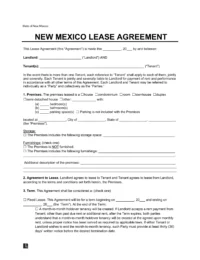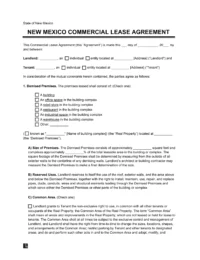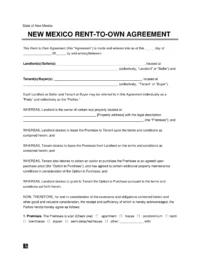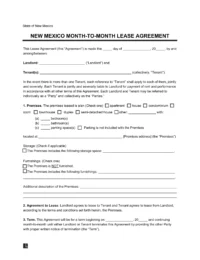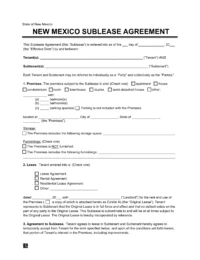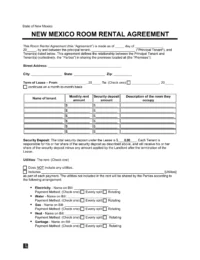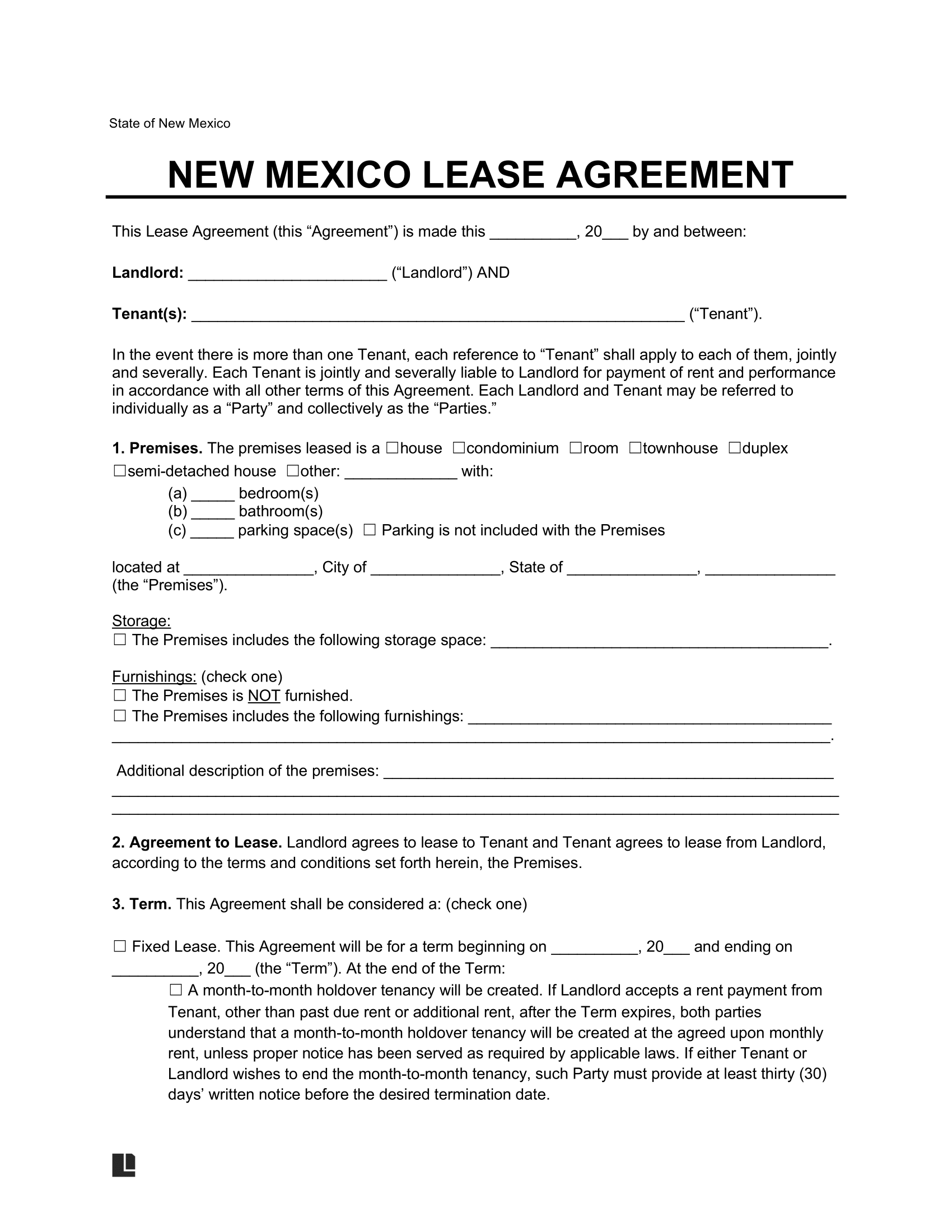A New Mexico lease agreement is a contract between a landlord and a tenant to use a rental property. This form defines the lease term’s length, the rent amount the tenant owes each month, guidelines on the presence of pets, the property’s address, and the landlord and tenant parties.
Rental Lease Laws Overview
- Rent Control: No
- Limit on Late Fees: Yes
- Late Fees in Rental Agreement: Yes
- Grace Period: No
- License Required for Landlord: No
Before signing a lease, use a rental application in the tenant screening process to identify suitable occupants.
By Type (6)
New Mexico Standard Lease Agreement
Outlines the terms and conditions for renting a residential property by a tenant from a landlord.
New Mexico Commercial Lease Agreement
Lets a landlord rent a commercial property to a business, allowing the business to conduct its operations there.
New Mexico Rent-to-Own Lease Agreement
Allows a tenant to purchase the property they're leasing from a landlord at a later date.
New Mexico Month-to-Month Rental Agreement
Renews on a monthly basis unless it is terminated.
New Mexico Sublease Agreement
A tenant can rent out their property to another person while still being accountable to the original landlord.
New Mexico Room Rental Agreement
Define rules and financial commitments while renting individual rooms within a shared dwelling.
Required Lease Disclosures
Landlords in New Mexico can familiarize themselves with two main lease disclosures:
- Lead paint disclosure: A landlord must warn a tenant that they may experience exposure to lead-based paint if they’re renting a house that was constructed before 1978. [1]
- Owner identity disclosure: A landlord must specify who’s allowed to access the premises and record an address for official notices. [2]
Security Deposit
- Maximum Amount: If the lease term is less than one year, a landlord may request up to one month’s rent for a security deposit. If the lease term is more than one year, there is no limit on how much a landlord can request. Note that if the landlord charges the tenant more than one month’s rent, they must pay interest to the tenant. [3]
- Receipts: Not specified.
- Interest Payments: Not required.
- Bank Account: The security deposit must be placed in an escrow bank account in a federally insured banking institution.
- Returning Requirements: A landlord must return a tenant’s security deposit within thirty days of the end of the lease. [4]
- Withholding Rules: The landlord can deduct from the security deposit for unpaid rent, utility bills, repair costs, and damages beyond normal wear and tear. They must provide a written, itemized list of these deductions along with the remaining deposit. [4]
Rent Payments
- Laws: Unless stated otherwise, the full rent is due at the start of each month. [5]
- Rent Control: Not allowed. [6]
- Late Fees and Grace Period: No grace period but a late fee cannot be more than 10% of the monthly rent. [7] If rent remains unpaid after this period, landlords can initiate eviction proceedings by issuing a 3-day notice to quit.
- Withholding Rent: If the landlord’s serious violation of the rental agreement impacts health and safety, the tenant can provide at least seven days’ notice and withhold one-third of the daily rent. If the unit is completely uninhabitable, the tenant may withhold all rent until the issue is fixed. [8]
Landlord Right of Entry
- Notice Requirements: A landlord must provide at least one day’s advance notice to a tenant before entering the rental property. [9]
- Keys, Locks, and Security: No provision.
Property Repairs
- Landlord Responsibilities: Landlords must keep rental units habitable, adhere to local housing and safety codes, and promptly address repairs. They must also provide essential utilities like electricity, plumbing, water, HVAC, and trash collection.
- Tenant Repairs: Tenants are responsible for maintaining their rental unit, including minor repairs and the cleanliness of fixtures. They should also regularly check the electrical, plumbing, and sanitation systems.
- Abandonment: If a tenant has abandoned the property for over seven days without notifying the landlord and is behind on rent, the landlord may assume the tenant has abandoned the unit. [10]
Terminating a Lease
- Month-to-Month Tenancy: Either party can terminate a month-to-month tenancy by providing a 30-day written notice to the other party. This notice period allows both the landlord and the tenant sufficient time to make necessary arrangements.
- Unclaimed Property: Landlords must store any personal property left by a tenant for at least 14 days before disposing of it. If the tenant has abandoned the property, the landlord must keep the belongings for at least 30 days and provide written notice of the intent to dispose of them. [11]
Sample
Download our New Mexico lease agreement template as a PDF or Word file so you can create your terms for a tenant’s occupancy:


